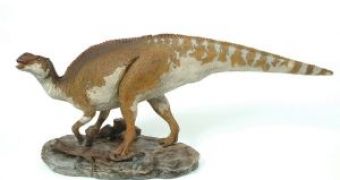Scientists at Boulder University of Colorado have found for the first time, in an exceptionally well preserved duck-billed dinosaur, evidence that these giants were infested with intestinal parasites.
The 75 million years old fossil of Brachylophosaurus canadensis (a duck billed dinosaur) (image) was discovered in Judith River Formation near Malta, Montana. Scientists found more than 200 suspected parasite burrows in 17 samples of gut material that seem to have been made by tiny worms similar to current nematodes. "Fossil evidence for interactions between dinosaurs and invertebrates usually involves insects," said Assistant Professor Karen Chin, also a curator of paleontology for the University of Colorado Museum and an internationally known expert in trace fossils. "This research is exciting because it provides evidence for the movement of tiny, soft-bodied organisms inside the gut cavity of a dinosaur."
The stomach traces seem to indicate only a single type of burrow. "Typically a carcass attracts multiple scavengers, and this one was largely undisturbed," said Justin Tweet, graduate student. "Since the carcass was apparently buried before it had a chance to fall apart, we think remnant parasites may have been living inside of the animal when it died."
Duck-billed dinosaurs were bipedal (walking on two legs), vegetarian, reaching up to 50 feet long and weighing up to three tons. Their main trait was their flat beak which made their heads resemble those of ducks, but they had some kind of "incisors" and "molars".
They had a complex behavior, attending their offspring and using sounds to communicate. "The gut contents of this dinosaur consists of a mix of fingernail-sized plant fragments mixed in a clay-rich matrix of sediment," said Tweet.
"Tiny white burrows visible throughout the gut-contents material were analyzed with microscopes connected to computer screens to chart their size and routes".
"The CU-Boulder researchers counted at least 10 cases of "paired burrows" sharing a common burrow wall in the dinosaur gut, and in several cases such burrows even match changes in direction, suggesting they were made by two individuals at the same time," said Chin.
"The parallel routes suggest short periods of sustained contact, which could be related to a social interaction such as mating," she said. "In addition, collaborator Dennis Braman of the Canadian Royal Tyrrell Museum in Drumheller, Alberta, has discovered pollen from 40 distinct plant species in the gut region of the dinosaur carcass".
"The wider interest in all of this is a better understanding of dinosaur ecology, including what they were eating and how they interacted with their contemporaries," Tweet said.

 14 DAY TRIAL //
14 DAY TRIAL //